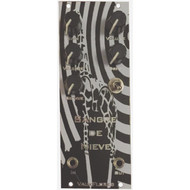Sangre De Nieve - Vaux Flores
by Ellison Wolf
One of the great things about modular synthesis, and in particular the Eurorack landscape, is that it allows people who are not—or would not consider themselves to be—experts in electronics, design, etc., a seat at the table, so long as they bring a dish to share. There’s definitely something to be said for expertise, but also the nascent knowledge of a “newbie” [or potentially somebody who could be just ignorant and/or lazy] that doesn’t feel constrained by so-called laws created by...well, by whom exactly? Case in point is Sangre De Nieve, a distortion* module by manufacturer Vaux Flores. I put the asterisk next to the word distortion because according to the Vaux Flores website, in the words of its brainchild Travis Johns, The Sangre de Nieve is:
“A Eurorack distortion module, which I believe in synth-speak, is a waveshaper or VCA or something along those lines. Not being totally lock-step into the world of wires, I really couldn’t tell you.”
You’ll never see that in a Roland product manual.
While some may scoff at this, and this type of stance definitely has its appropriate settings [I hope I never hear my doctor utter a similar phrase in med speak], I say no harm, no foul, and if you like distortion [or waveshaping, or VCAs, or…] you might want to stock up on bandages and a puffy jacket.
Indeed, Sangre De Nieve is a Eurorack module with a mildly psychedelic look: A Black, white, and silver faceplate with a giraffe for adornment, and that’s about it. With no screen, buttons, nothing that lights up, no hidden functions, no potential firmware updates, not even CV control over anything, Sangre De Nieve operates more like a distortion pedal in Eurorack format rather than it does a typical modern day action-packed bursting-at-the-seams module. I was somewhat surprised to see that the lack of CV control was intentional, and this is also mentioned on the website as well:
“The controversial part: there’s absolutely no voltage control at all on this thing. This is quite intentional and by design. It’s entirely OK for things just to do things and not have to control other things. In people, we call this at one extreme, being an individual and at the other, simply not being a jerk...it's also ok to just go off and do your own thing and be a part of the universal choir on your own terms without the electrical prods of several other entities.”
Johns definitely has his own brand of moxie, and when it comes to distortion, the need for some attitude, and its translation into a module serves him well, though I’m not sure I’d term the lack of CV controversial. But let’s not dwell on this longer, as there are controls on the module for which to talk about. There is an IN. There is an OUT. There are five knob based parameters with which to control things: GAIN, VOLUME, VOLTAGE, DRIVE, AND OCTAVE.
GAIN allows for input control so you’re not limited to just patching oscillators into SDN, and can smash your guitar, drums, vocals, doorbell, what have you. DRIVE, well, adds drive, and OCTAVE, well, let’s see what Johns says about that and the rest of the controls:
“OCTAVE shapes the blend between the first gain stage and the octave drop. The VOLTAGE knob drops the voltage to the first gain stage ever so slightly to let extra magic seep through and the switch toggles between your respective octaves. Finally, the VOLUME control does exactly what you think it would do.”
Moxie. Embrace it. In play, I couldn’t tell you what the OCTAVE control functionally did to the sound, though it did seem to operate as kind of an LFO. The same inexplicability
occurs with the VOLTAGE. Both did, however, skew the sound in various unpredictable ways. Mind you, I did not say uncontrollable, just unpredictable. Both attributes have their time and place.
I found Sangre De Nieve to be a very usable distortion, and while it would be nice to have the ability to throw some CV around [my own not-so-controversial statement about this module], especially for the GAIN and DRIVE settings, fans of distortion will be pleased. Sangre De Nieve has the ability to go from fuzzy carpet bombing to glitchy stutters without ever losing the core of the input—no small feat. Does my description of the sound help? No, of course not. Describing distortion in the modular world is like describing the taste of table sugar to a candy addicted tween.
While in the middle of testing out the module and switching inputs, I delighted to find that with nothing plugged into the Input there was still something coming out of the Output; a kind of mildly filtered twitchy, bird-on-speed type of chirping, that could be transformed by a literal flip of the [toggle] switch to a hyperactive morse code operator, naturally depending on knob settings, and always with a constant motor-boating in the background. It made for an interesting rhythmic sound source and patched into the Casper/Bastl Ikarie produced some really interesting watery type of formant sounds and inspiring rhythms in which to build off of. Sangre De Nieve gets extra credit in the misuse department, fer sure.
Look, you won’t mistake this homebrew device for the latest Intellijel module or anything, but that again, is a plus, like that excellent surprise appetizer brought by that mysterious guest in a dirty Tupperware dish who seems not to know who the host is. It’s boutique [yes, that oh, so-tired-word], or in other, better, words, not every person on your street with a modular setup will have it, like they do Beads or Maths or whatever, and that’s a good thing: It can be your our dirty little distorted secret.
10 HP
Price $139


